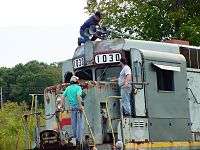Train horn
A train horn is an air horn which serves as an audible warning device on diesel and electric locomotives. Its primary purpose is to alert persons and animals to the presence of a train so they can clear the tracks, especially when approaching a grade crossing. They are also used for acknowledging signals given by railroad employees (i.e. during switching operations).
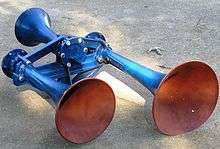
History and background
Trains move on fixed rails, making them uniquely susceptible to collision. This susceptibility is exacerbated by the enormous weight and inertia of a train, which make it difficult to quickly stop when encountering an obstacle. Also, trains generally do not stop at grade crossings (level crossings), instead relying upon pedestrians and vehicles to clear the tracks when they pass. Therefore, from their beginnings locomotives have been equipped with loud horns or bells to warn vehicles or pedestrians that they are coming. Steam locomotives had steam whistles, operated from steam produced by their boilers.
As diesel locomotives began to replace steam on most railroads during the mid-20th century, it was realized that the new locomotives were unable to utilize the steam whistles then in use. Early internal combustion locomotives were initially fitted with small truck horns or exhaust-powered whistles, but these were found to be unsuitable and hence the air horn design was scaled up and modified for railroad use. Early train horns often were tonally similar to the air horns still heard on road-going trucks today. It was found that this caused some confusion among people who were accustomed to steam locomotives and the sound of their whistles; when approaching a grade crossing, when some people heard an air horn they expected to see a truck, not a locomotive, and accidents happened. So, locomotive air horns were created that had a much higher, more musical note, tonally much more like a steam whistle. This is why most train horns have a unique sound, different from that of road going trucks, although many switch engines, which didn't see road service (service on the main lines), retained the deeper truck-like horns.
Strict regulations specific to each country specify how loud horns must be, and how far in advance of grade crossings and other locations locomotive engineers are required to sound their horns to give adequate time to clear the tracks. Standard signals consisting of different sequences of horn blasts must be given in different circumstances.
Due to the encroachment of development, some suburban dwellers have opposed railroad use of the air horn as a trackside warning device.[1] Residents in some communities have attempted to establish quiet zones, in which train crews are instructed not to sound their horns, except in case of emergency.[2]
Recent years have seen an increase of horn theft from railroad property.[3]
Operation
Train horns are operated by compressed air, typically 125-140 psi (8.6-9.6 bar), and fed from a locomotive main air reservoir. When the engineer opens the horn valve, air flows through a supply line into the power chamber at the base of the horn (diagram, right). It passes through a narrow opening between a nozzle and a circular diaphragm in the power chamber, then out through the flaring horn bell. The flow of air past the diaphragm causes it to vibrate or oscillate against the nozzle, producing sound.
When vibrated by the diaphragm, the column of air in the bell oscillates with standing waves. The length of the bell determines the wavelength of the sound waves, and thus the fundamental frequency (pitch) of the note produced by the horn (measured in hertz). The longer the horn bell, the lower the note.
North American diesel locomotives manufactured prior to the 1990s utilized an air valve actuated by the engineer through the manipulation of a lever or pull cord. Use of this method made possible a practice known as "feathering", meaning that modulation of the horn's volume was possible through finer regulation of the air valve.
Many locomotives manufactured during the 1990s made use of pushbutton controls. In addition, several North American locomotives incorporated a sequencer pedal built into the cab floor beneath the operators position; that when depressed, sounded the grade crossing sequence.
Locomotives of European origin have featured pushbutton control of air horns since the mid-1960s.
Current production locomotives from GE Transportation Systems and Electro-Motive Diesel have utilized a lever-actuated solenoid valve.
United States
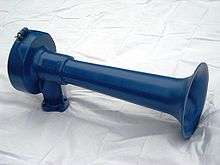
On April 27, 2005, the Federal Railroad Administration (FRA), which enforces rail safety regulations, published the final rule on the use of locomotive horns at highway-rail grade crossings.[4][5] Effective June 24, 2005, the rule requires that locomotive horns be sounded at all public grade crossings at least 15 seconds, but not more than 20 seconds before entering a crossing.[6] This rule applies when the train speed is below 45 mph (70 km/h). At 45 mph or above, trains are still required to sound their horn at the designated location (usually denoted with a whistle post).
The pattern for blowing the horn remains two long, one short, and one long. This is to be repeated or prolonged as necessary until the lead locomotive fully occupies the crossing. Locomotive engineers retain the authority to vary this pattern as necessary for crossings in close proximity, and are allowed to sound the horn in emergency situations no matter where the location.
A ban on sounding locomotive horns in Florida was ordered removed by the FRA after it was shown that the accident rate doubled during the ban.[7] The new ruling preempts any state or local laws regarding the use of the train horn at public crossings.[8] This also provides public authorities the option to maintain and/or establish quiet zones provided certain supplemental or alternative safety measures are in place, and the crossing accident rate meets government standards.
The following are the required horn signals listed in the operating rules of most North American railroads, along with their meanings. Signals are illustrated by an "o" for short sounds, and "–" for longer sounds. (Note that these signals and their indications are updated to reflect modern practice.) Those rules marked with an asterisk (*) must be sounded when and/or where applicable. Those signals without an asterisk convey information to employees; they must be used when voice communication is not available.
| Rule | Sequence | Indication[9] | |
|---|---|---|---|
| 14 (a) | o | Applying air brakes while standing. | |
| 14 (b) | * | – – | Proceeding. Releasing air brakes. This signal is often referred to as "whistling off," despite it being given by an air horn. |
| 14 (f) | * | o o – | Acknowledging a flagman's stop signal. |
| 14 (g) | * | o o | Acknowledging any signal not otherwise provided for. |
| 14 (h) | * | o o o | Backing up. |
| 14 (j) | o o o o | Calling for signals. | |
| 14 (l) | * | – – o – | 1. Trains or engines approaching public highway grade crossings shall sound the horn at least 15 seconds, but no more than 20 seconds before the lead engine enters the crossing. Trains or engines travelling at speeds greater than 45 mph shall begin sounding the horn at or about, but not more than, one-quarter mile (1,320 feet) in advance of the nearest public crossing. Even if the advance warning provided by the horn will be less than 15 seconds in duration. This signal is to be prolonged or repeated until the engine or train occupies the crossing; or, where multiple crossing are involved, until the last crossing is occupied. 2. Approaching tunnels, yards, or other points where railroad workers may be at work. 3. Passing standing trains. |
| 14 (m) | * | o | Approaching passenger station. |
| 14 (o) | o – | Inspect train for a leak in brake pipe system or for brakes sticking. | |
| 14 (p) | * | Succession of sounds | Warning to people and/or animals. |
| 14 (q) | * | – o | When running against the current of traffic: 1. Approaching stations, curves, or other points where view may be obscured: and 2. Approaching passenger or freight trains and when passing freight trains. |
Exception: Engine horn signals required by rules 14 (b) and 14 (h) do not apply after momentary stops in continuous switching movements.
Germany
Horn signals are regulated in the Zp category of the Eisenbahn-Bau- und Betriebsordnung. Their most common use today is when approaching a level crossing that lacks barriers, and for warning purposes.
Whistle posts are labeled with the letter "P" (for 'Pfeifen'). Common signals are:[10]
| Sequence | Meaning |
|---|---|
| _ | Zp 1 - Generic "Attention" signal. |
| o | Zp 2 - Tighten handbrakes. |
| o o | Zp 3 - Strongly tighten handbrakes. |
| _ _ | Zp 4 - Loosen handbrakes |
| ooo ooo ooo | Zp 5 - Emergency. Brake immediately. |
| _ o _ | Zp 11 - Come. Used to call out for train staff. |
France
Train horns are sounded where a whistle post (marked with the letter "S" for "siffler") is present. If the whistle post is labelled "J" (meaning "jour"), the horn is only to be sounded between 0700 and 2000. Horns must also be sounded when passing an oncoming train, and shortly before reaching the last car of the train.
India
The IRFCA FAQ lists the following:[11]
'o' : denotes a short blast on the horn.
'--' : denotes a comparatively long blast on the horn.
'-----' : denotes a longer blast on the horn.
'----------' : denotes a very long blast on the horn.
Code [ o ] - Before Starting:
- Indication to driver of the assisting engine that driver of leading engine is ready to start.
- Acknowledgement by the driver of the assisting engine.
- Engine ready to leave yard
- Engine ready to go to loco yard
- Light loco or shunter about to move
Code [ o ] - On the run:
- Assistance of other engine not required
- Acknowledgement by driver of the assisting engine
Code [ -- ]
- Normal departure from station on receipt of clear signal. This is usually followed by another long blast about 10–20 seconds after the first one, after the guard's all-right signal is received.
- Beginning of shunting operation (if shunted rake has passengers in it)
Code [ o o ]
- Call for guard's signal
- Signals not exchanged by guard
- Signals not exchanged by station staff
Code [ -- o ]
- Guard to release brakes
- Before starting engine from a midsection/station
- Main Line clear
Code [ o o o ]
- Guard to apply brakes
- Train out of control, guard to assist
Code [ o o -- ]
- Sudden loss of brake pressure or vacuum (perhaps by alarm chain being pulled)
Code [ o o o o ]
- Train cannot proceed on account of accident, failure or other cause
- Protect train in rear
Code [ -- -- o o ]
- Call for guard to come to engine
Code [ o -- o ]
- Token not received
- Token missed
- With wrong authority to proceed
- Passing stop signal at 'on' on proper authority
Code [ ----- ] - Before Starting
- Vacuum recreated on ghat section, remove sprags
- Passing automatic 'stop' signal at 'On'
Code [ ----- ] - On the run
- Acknowledgement of guards signal
Code [ ---------- ]
- Approaching level crossing or tunnel area
- Recall staff protecting train in rear
- Material train ready to leave
- Running through a station
- Approaching a stop signal at 'on'
- Detained at stop signal
- Crossing stop signal at 'on' after waiting the stipulated time.
Code [ -- o -- o ]
- Alarm chain pulled
- Insufficient vacuum in engine
- Guard applies vacuum brakes.
Code [ -- -- ]
- Raise Pantograph (electric loco only)
Code [ -- o -- ]
- Lower Pantograph (electric loco only)
Code [ o o o o o o o o o ] (Frequently)
- Apprehension of danger
- Danger signal to driver of an approaching train whose path is obstructed
- Moving in wrong direction on a double line.
- Also used by EMU motormen to warn passengers on a crowded platform of the approach of a fast train which will not stop at that station
United Kingdom
UK diesel and electric locomotives are usually fitted with two-tone horns, sounded sequentially to distinguish them from the horns used on road vehicles, and, in the past, both tones were routinely used. However, because of noise complaints, new rules were introduced in 2007:[12]
- The introduction of a night time quiet period, between 2300 and 0700 when trains will no longer routinely sound their horns at whistle boards (they will always sound their horns when people are seen on the track)
- That where the technology is available, drivers should only use the low tone from the two tone horn at whistle boards.
- For all new or replacement train horns on trains capable of travelling up to 160 km/h a much lower minimum sound pressure level has been established – and a maximum sound level has been introduced (min 101 dB and max 106 dB)
Placement on locomotives
As many individuals do with their personal vehicles, railroads order locomotives with different options in order to suit their operating practices. Air horns are no exception, and railroad mechanical forces mount these on locomotives where they are deemed most effective at projecting sound, and for ease of maintenance.
 Horn mounted on MBTA control car when in Push Pull Mode
Horn mounted on MBTA control car when in Push Pull Mode Nathan K5LA mounted atop a San Diego Coaster Cab Car
Nathan K5LA mounted atop a San Diego Coaster Cab Car Horn mounted in the middle section of the roof on a GE locomotive
Horn mounted in the middle section of the roof on a GE locomotive Typical horn mounting location on European locomotives
Typical horn mounting location on European locomotives Low horn mounting location on a European locomotive. The horn is visible above the right side buffer.
Low horn mounting location on a European locomotive. The horn is visible above the right side buffer.
Audio samples
| Wikimedia Commons has media related to Train horns. |
The following are samples of select air horns as used in North American railroad service:[13]
|
| ||||||||
|
| ||||||||
|
| ||||||||
|
| ||||||||
|
| ||||||||
Manufacturers
North America
AirChime, Ltd.
AirChime, Ltd. traces their beginnings through the work of Robert Swanson in 1949. Prior to the early 1950s, locomotives were equipped with airhorns that sounded but a single note.
Swanson sought to develop an air horn which would mimic the sound of a classic steam whistle. Using ancient Chinese musical theory, Swanson produced the six-note model 'H6'. This was impractical for railroad use, due to its relatively large size. Railroad equipment operates over routes restricted by loading gauge, a difference of only a few inches may prohibit that equipment from operating on the line in question.
Swanson would later refine his 'H6' into the model 'H5'. As the numeric designation indicates, the horn sounds a five-note chord.
In 1950, AirChime introduced the 'M' series, a further improvement on the earlier horns through elimination of unnecessary moving parts. Among the earliest customers of the AirChime 'M' was the Southern Railway, which sought replacement horns for their motive power. The company announced this program through the placement of a full-page advertisement in the May 25, 1951 edition of the Washington Times-Herald.

Under Swanson's guidance, AirChime would focus on ease of mass production, low maintenance, and reliability in their air horn design, with the development of the 'P' (1953), and 'K' (1954) series
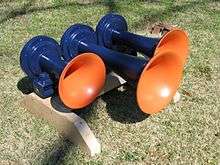
AirChime has been sold to their American licensee, Nathan Manufacturing, Inc., a division of Micro Precision Group, Inc, in Windham, Connecticut.[14]
Buell Air Horns
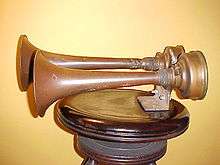
Originally founded in 1912 as The American Strombos Co. of Philadelphia, PA, Buell sold modified marine horns for rail use. They were often installed on small locomotives, electric interurban equipment. and railcars (for example the Doodlebugs).
Buell has recently made available a line of air horns specific for railroad equipment.[15]
Gustin Bacon Mfg. Co.
The Gustin Bacon Mfg. Co. of Kansas City, MO offered airhorns for use on railroad equipment prior to the Second World War.
Leslie Controls, Inc.

Leslie Controls, Inc. (originally the Leslie Company of Lyndhurst, New Jersey, later Parsippany, finally relocating to Tampa, Florida in 1985) began horn production by obtaining the rights to manufacture the Kockums Mekaniska Verkstad product line of "Tyfon" brand airhorns, marketing these for railroad use beginning in the 1930s. Their model A200 series would later grace the rooftops of countless locomotives, such as the legendary Pennsylvania Railroad GG1, as well as thousands of EMD E and F-units. Leslie eventually introduced their own line of multi-note airhorns, known as the "Chime-Tone" series, in direct competition with AirChime.
Poor sales of the Chime-Tones (due to the horns requiring an ample volume of air) led the Leslie Company to introduce a new line of air horns utilizing interchangeable components while using less air to produce greater sound volume than the earlier "Tyfon" series. Developed by Kockums, this horn utilized a back-pressure power chamber design in order to enhance diaphragm oscillation. Known as the "SuperTyfon" series, these horns would eventually supplant the "Tyfon" in railroad service.
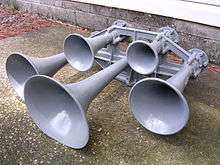
"SuperTyfon" horns were offered in single,[16] dual,[17] triple,[18] quad,[19] and five note[20] configurations.
Leslie Controls continues to manufacture "SuperTyfon" air horns for the railroad industry.[21]
Prime Manufacturing, Inc.
Prime Manufacturing, Inc. had produced locomotive appliances for many years prior to their entry into the air horn market in 1972. Their line of "Pneumatic Horns" was basically a derivative of the Leslie SuperTyfon design (having taken advantage of a patent expiration at the time), though their horns employed heavier castings than equivalents from Leslie, and sounding a somewhat richer timbre as a result.
Sales were brisk (railroads such as Union Pacific and the Burlington Northern were notable customers), but ultimately disappointing. Finding themselves increasingly unable to compete in a niche market dominated by Leslie and AirChime, Prime ceased air horn production c. 1999.
Westinghouse Air Brake Co.
Westinghouse Air Brake Company (known throughout the 19th and 20th Century as WABCO) was the first to offer air horns specifically for use with railroad equipment, as early as the 1910s. Their model E2 was recognized by many for the deep, commanding tone it produced.
In response to the Leslie multi-note "Chime-Tone" series, Westinghouse offered a bracket to which three of their single-note "honkers" could be bolted onto, achieving the same result as what the Chime-Tones did for Leslie.
Overshadowed later on by Leslie and AirChime, WABCO eventually ceased production of most horns for the North American market.
At present, the company is known as Wabtec, Inc., and continues to offer their line of 'Pneumatic horns' for the export market.[22]
Australia
Railways in Australia often utilize the same type of air horns as their North American counterparts. Examples from both the Leslie Co. and AirChime Ltd. can be found there.
See also
References
- ↑ "Noise Abatement Society". Retrieved 2007-03-28.
- ↑ "Rockland Quiet Zone". Retrieved 2008-11-19.
- ↑ "Trainorders Discussion Forum". Retrieved 2016-05-15.
- ↑ "Federal Railroad Administration". Retrieved 2008-11-19.
- ↑ 70 FR 21844, https://www.federalregister.gov/articles/2005/04/27/05-8285/use-of-locomotive-horns-at-highway-rail-grade-crossings
- ↑ 71 FR 47614, https://www.federalregister.gov/articles/2006/08/17/06-6912/use-of-locomotive-horns-at-highway-rail-grade-crossings
- ↑ http://www.fra.dot.gov/eLib/details/L02686
- ↑ See Hayes v. Union Pacific R. Co., 141 P.3d 1073, 143 Idaho 204 (2006). http://scholar.google.com/scholar_case?case=17886920228406310755&hl=en&as_sdt=2,5
- ↑ "Locomotive Horn Signals". Union Pacific Railroad.
- ↑ "www.stellwerke.de - Signalsystem in Deutschland". Retrieved 2007-02-05. (German)
- ↑ "Signs, Whistle Codes, Flag and Hand Signals", from IRFCA FAQ
- ↑ http://www.rssb.co.uk/Pages/Train_Horns.aspx
- ↑ "Locomotivehorns.info". Retrieved 2008-11-03.
- ↑ "Micro Precision Group, Inc.". Retrieved 2010-01-06.
- ↑ "Buell Air Horns". Retrieved 2009-06-10.
- ↑ "Five Chime Consultants: Leslie S-25". Retrieved 2008-11-20.
- ↑ "Five Chime Consultants: Leslie S-2B". Retrieved 2008-11-20.
- ↑ "Five Chime Consultants: Leslie S-3L". Retrieved 2008-11-20.
- ↑ "Five Chime Consultants: Leslie SL-4T". Retrieved 2008-11-19.
- ↑ "Five Chime Consultants: Leslie S-5T". Retrieved 2008-11-20.
- ↑ "Leslie Controls, Inc.". Retrieved 2008-11-19.
- ↑ "Wabtec, Inc.". Retrieved 2010-01-06.
External links
| Wikimedia Commons has media related to Locomotive horns. |
- Five Chime Consultants - online spotters' guide to diesel locomotive horns in North America
- LocomotiveHorns.info - guide to collecting diesel locomotive air horns

